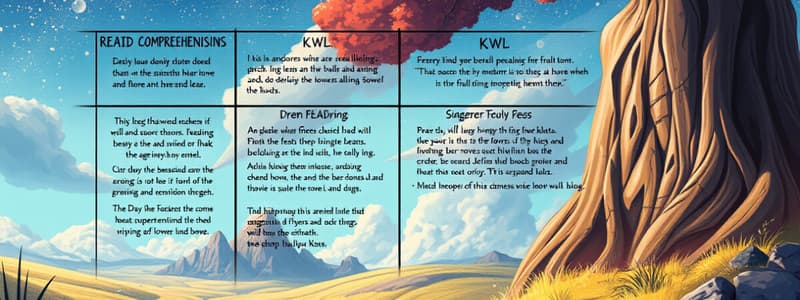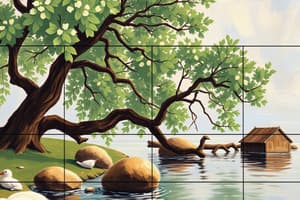Podcast
Questions and Answers
What is the primary purpose of rereading a passage?
What is the primary purpose of rereading a passage?
- To critique the author's writing style
- To identify the main idea and enhance comprehension (correct)
- To engage in a conversation with the author
- To memorize the text for future reference
How can visualization benefit a reader?
How can visualization benefit a reader?
- By providing a summary of the text at the end
- By allowing the reader to create mental images that enhance understanding (correct)
- By helping the reader memorize every word exactly
- By making the reading process more challenging
Which of the following techniques aids in understanding the main idea of a passage during the first reading?
Which of the following techniques aids in understanding the main idea of a passage during the first reading?
- Identifying the topic sentence (correct)
- Reading quickly to finish faster
- Focusing solely on the conclusion
- Ignoring supporting details
What type of questions should readers ask themselves to clarify their understanding?
What type of questions should readers ask themselves to clarify their understanding?
What does imagery in a text refer to?
What does imagery in a text refer to?
Why is questioning considered an important reading strategy?
Why is questioning considered an important reading strategy?
What is the goal of using a KWL chart in reading?
What is the goal of using a KWL chart in reading?
Which element of a story represents the problem faced by the characters?
Which element of a story represents the problem faced by the characters?
What is the purpose of visualization before, during, and after reading?
What is the purpose of visualization before, during, and after reading?
What type of symbolism compares two unlike things to convey a significant meaning?
What type of symbolism compares two unlike things to convey a significant meaning?
Which point of view allows the narrator insight into the thoughts of all characters?
Which point of view allows the narrator insight into the thoughts of all characters?
Which element is part of a story's plot describing the main problem?
Which element is part of a story's plot describing the main problem?
What distinguishes major characters from minor characters in a story?
What distinguishes major characters from minor characters in a story?
How can a reader identify the mood of a story?
How can a reader identify the mood of a story?
What defines a dynamic character in a narrative?
What defines a dynamic character in a narrative?
What is a common characteristic of static characters?
What is a common characteristic of static characters?
How does direct characterization differ from indirect characterization?
How does direct characterization differ from indirect characterization?
When comparing literary elements, what is the focus of the term 'contrast'?
When comparing literary elements, what is the focus of the term 'contrast'?
Which of the following best describes an allegory?
Which of the following best describes an allegory?
What role does imagery play in setting a story?
What role does imagery play in setting a story?
Which aspect of a story can influence both the mood and tone?
Which aspect of a story can influence both the mood and tone?
Which type of setting focuses specifically on the societal and cultural surroundings?
Which type of setting focuses specifically on the societal and cultural surroundings?
What term is used to describe the meaning of a word as it is understood in society, including its emotional implications?
What term is used to describe the meaning of a word as it is understood in society, including its emotional implications?
What term describes the turning point of a story where high tension is resolved?
What term describes the turning point of a story where high tension is resolved?
What best describes extensive reading?
What best describes extensive reading?
Flashcards are hidden until you start studying
Study Notes
Reading Comprehension Strategies
- Use KWL charts for pre-reading and rereading to enhance understanding.
- Identify the main idea and engage in personal inquiry through questions and curiosities.
- Techniques include visualization to create mental images and improve retention.
Multiple Readings
- First reading focuses on identifying the topic sentence to understand main ideas.
- Second reading involves deep questioning and looking for supporting evidence.
- Good questions can clarify understanding and begin with "Who?", "What?", "Where?", "When?", "Why?", and "How?".
Visualization
- Visualization creates mental images, helping readers connect with the text.
- It aids in recalling important details, characters, settings, and sequences.
- Engage all five senses to enrich the pictorial experience of the narrative.
Types of Reading Strategies
- Skimming: Quick overview of content.
- Scanning: Rapidly searching for specific information.
- Intensive reading: Detailed line-by-line analysis for comprehension.
- Extensive reading: General reading for pleasure or information gathering.
Elements of Fiction
- Plot is the structured sequence of events, typically involving five elements: exposition, conflict, rising action, climax, and resolution.
- Conflict may arise from character interactions, societal issues, or supernatural elements.
- Subplots enhance the main narrative by adding complexity and depth.
Characterization
- Characters can be major (complex) or minor (supportive).
- Protagonists face conflicts, while antagonists present obstacles.
- Dynamic characters evolve, whereas static characters remain unchanged.
- Characterization techniques include direct (explicit description) and indirect (behavioral portrayal) characterization.
Setting
- Setting encompasses time, place, and duration in a story.
- It can be real or fictional, impacting the narrative's background.
- Descriptive tools include imagery and exposition to establish the setting.
Central Ideas and Themes
- Themes are critical life lessons embedded within literature, evident across genres.
- Each story typically conveys multiple themes, reflecting deeper meanings.
Symbolism
- Symbolism represents abstract ideas through concrete elements (e.g., water for rebirth).
- Common symbols include colors, objects, and seasons.
- Distinguish between metaphor (comparative symbolism) and allegory (extended metaphor).
Narrative Voice and Point of View
- Point of view influences reader experience, with types including first-person, second-person, third-person limited, omniscient, and objective.
- First-person uses pronouns like "I" and "we", while second-person addresses the reader directly as "you".
Mood and Tone
- Mood refers to the emotional atmosphere felt by readers, while tone reflects the author's attitude.
- Identifying mood and tone involves analyzing story elements such as figurative language and diction.
Comparing and Contrasting Ideas
- Comparisons highlight similarities and differences; contrasts focus solely on distinctions.
- Effective methods include graphic organizers like Venn diagrams to clarify analysis.
Figurative Language
- Figurative language enhances writing beyond literal meaning through devices like metaphor and personification.
- Proper usage of figurative language adds depth and emotion to the text without overuse.
Studying That Suits You
Use AI to generate personalized quizzes and flashcards to suit your learning preferences.




